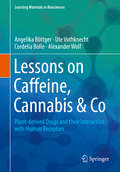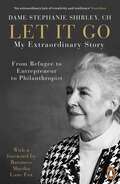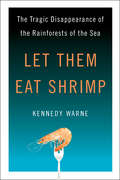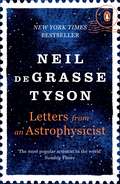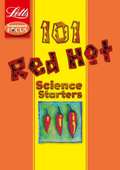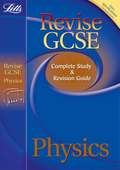- Table View
- List View
Lessons in Scientific Computing: Numerical Mathematics, Computer Technology, and Scientific Discovery
by Norbert SchorghoferTaking an interdisciplinary approach, this new book provides a modern introduction to scientific computing, exploring numerical methods, computer technology, and their interconnections, which are treated with the goal of facilitating scientific research across all disciplines. Each chapter provides an insightful lesson and viewpoints from several subject areas are often compounded within a single chapter. Written with an eye on usefulness, longevity, and breadth, Lessons in Scientific Computing will serve as a "one stop shop" for students taking a unified course in scientific computing, or seeking a single cohesive text spanning multiple courses. Features: Provides a unique combination of numerical analysis, computer programming, and computer hardware in a single text Includes essential topics such as numerical methods, approximation theory, parallel computing, algorithms, and examples of computational discoveries in science Written in a clear and engaging style Not wedded to a specific programming language
Lessons in Scientific Computing: Numerical Mathematics, Computer Technology, and Scientific Discovery
by Norbert SchorghoferTaking an interdisciplinary approach, this new book provides a modern introduction to scientific computing, exploring numerical methods, computer technology, and their interconnections, which are treated with the goal of facilitating scientific research across all disciplines. Each chapter provides an insightful lesson and viewpoints from several subject areas are often compounded within a single chapter. Written with an eye on usefulness, longevity, and breadth, Lessons in Scientific Computing will serve as a "one stop shop" for students taking a unified course in scientific computing, or seeking a single cohesive text spanning multiple courses. Features: Provides a unique combination of numerical analysis, computer programming, and computer hardware in a single text Includes essential topics such as numerical methods, approximation theory, parallel computing, algorithms, and examples of computational discoveries in science Not wedded to a specific programming language
Lessons in Sustainable Development from China & Taiwan (Comparative Studies of Sustainable Development in Asia)
by S. HsuBoth Taiwan and China are extremely populous nations that, due to population pressures and continuing high growth levels, have experienced challenges in sustainable development. Hsu illustrates Taiwan's path toward sustainable development and contrasts it to that of China, suggesting ways in which Taiwan can help China implement its environmental and social policies, and in which China might help Taiwan continue its path toward sustainable environmental and social policies. She explains that although Taiwan is a small compared to China, some aspects of its development model can (and should) be scaled up for larger countries. The importance of regulation enforcement is clear regarding Taiwan's environmental protection program, as is the promotion of small and medium sized enterprises in promoting income and social equality. Similarly, China's experimental methodology - using small areas to explore different ways of living or different technologies - can be useful in Taiwan. In Lessons in Sustainable Development, Hsu examines China and Taiwan in terms of inequality and environmental issues.
Lessons in Sustainable Development from Japan and South Korea (Comparative Studies of Sustainable Development in Asia)
by W. Zhang S. Hsu M. NaoiLessons in Sustainable Development from Japan and South Korea provides a concise overview of sustainable development in Japan and South Korea. Hsu, Naoi, and Zhang focus on environment, energy, health, technology, biodiversity, production, governance, well-being, livelihood, regulation, property rights, and minerals as indicators of sustainable development. Japan has greatly improved its environment since the industrialization process ended in the 1970s. The nation also has excellent health care and transportation systems. However, Japan continues to struggle with gender inequality and traffic congestion. Poverty and inequality have remained challenges since the 1990s. Similarly, South Korea is continuing to improve its environment, as well as its health care system, but struggles with gender inequality, poverty, and inequality. The countries can benefit from better social policies, as well as from a partnership in improving energy self-sufficiency, including enhancement of renewable energy technologies.
Lessons on Caffeine, Cannabis & Co: Plant-derived Drugs and their Interaction with Human Receptors (Learning Materials in Biosciences)
by Angelika Böttger Ute Vothknecht Cordelia Bolle Alexander WolfThis textbook provides a structured, easy to understand and thorough insight into the mode of function of plant secondary metabolites in plants and humans. It explains the biosynthesis and molecular action of nicotine, cannabis, caffeine and Co, describes the effects of these drugs on signal transduction at receptors and ion channels in animals, their relevance for human health and their potential for recreational use and abuse. It also offers a broad and comprehensive understanding on the role and function of these diverse molecules for the plants that make them. This textbook is written for master students and scientist in biochemistry and biology as well as for pharmaceutical and medical students. It will be a valuable study tool for teachers and students alike.
Lessons on Synthetic Bioarchitectures: Interaction of Living Matter with Synthetic Structural Analogues (Learning Materials in Biosciences)
by Eva-Kathrin Ehmoser-Sinner Cherng-Wen Darren TanThis textbook discusses the new relationship between artificial, synthetic material and living matter, and presents defined examples of approaches aiming for the creation of artificial cells. It also offers insights into the world of synthetic biology from its origins to the present day, showing what is currently possible in this discipline. Furthermore, it examines the ethical concerns and potential threats posed by this new field. The textbook is based on a lecture of the same title, held for master’s students at the University of Natural Resources and Life Sciences (BOKU), Vienna, and is primarily intended for students of synthetic biology, biotechnology and bioengineering. It is also of interest to research scientists from other disciplines wishing to learn more about the state of the art of synthetic biology and its future.
Let It Go: My Extraordinary Story - From Refugee to Entrepreneur to Philanthropist
by Dame Stephanie Shirley CHA moving memoir from a woman who made a fortune in a man's world and then gave it all away...soon to be turned into a filmIn 1962, Stephanie 'Steve' Shirley created a software company when the concept of software barely existed. Freelance Programmers employed women to work on complex projects such as Concorde's black box recorder from the comfort of their own home. Shirley empowered a generation of women in technology, giving them unheard of freedom to choose their own hours and manage their own workloads. The business thrived and Shirley gradually transferred ownership to her staff, creating 70 millionaires in the process.Let It Go explores Shirley's trail blazing career as an entrepreneur but it also charts her incredible personal story - her dramatic arrival in England as an unaccompanied Kindertransport refugee during World War Two and the tragic loss of her only child who suffered severely from Autism.Today, Dame Stephanie Shirley is one of Britain's leading philanthropists, devoting most of her time, energy and wealth to charities that are close to her heart. In Let It Go, Shirley tells her inspirational story and explains why giving her wealth away - letting it go - has brought her infinitely more happiness and fulfilment than acquiring it in the first place.Co-written with Richard Askwith, the former Executive Editor of The Independent and the award-winning author of seven books in his own name, including biographies of Emil Zátopek and Lata Brandisová.'An extraordinary tale of creativity and resilience' - Guardian'This engrossing story of an extraordinary life is filled with lessons in what it means to be human' - Financial Times
Let Me Not Be Mad: A Story of Unravelling Minds
by A K BenjaminLet Me Not Be Mad is an immersive, virtuosic and provocative investigation of madness, love and self-destruction that defies categorisation. 'Exhilarating ... dazzling ... a miraculous feat' Guardian'I have rarely read a more haunting and enthralling account of a descent into madness' Stephen Fry'Stunning: clever, troubling, restless, honest, dishonest' Olivia LaingA consulting room with two people in it. One of them is talking, the other is listening. Both of them need help.Throughout his life, A K Benjamin has found himself drawn to extreme behaviour – as a screenwriter, a contemplative monk, a counsellor for addicts, a support-worker for gang-members and ultimately as a clinical neuropsychologist.His book begins as a series of superbly realised clinical encounters with anonymised patients, some recently traumatised, some on the brink of mental collapse, others already in freefall. But with each encounter, it becomes increasingly and disturbingly apparent that what we are reading is not really about the patients at all: it is about the author’s own fevered descent into mental illness and mania as he confronts his traumatic past. Layered with twists and revelations, Let Me Not Be Mad challenges the boundary between fact and fiction to provide a thrilling drama of self-diagnosis: a hall of mirrors blazing with energy, intensity, humour and emotion. And though shockingly personal, it also reveals something deep and dark in western culture that is driving millions of us to distraction and collapse.
Let the Evidence Speak: Using Bayesian Thinking in Law, Medicine, Ecology and Other Areas
by Alan JessopThis book presents the most important ideas behind Bayes’ Rule in a form suitable for the general reader. It is written without formulae because they are not necessary; the ability to add and multiply is all that is needed. As well as showing in full the application of Bayes’ Rule to some quantitatively simple, though not trivial, examples, the book also convincingly demonstrates that some familiarity with Bayes’ Rule is helpful in thinking about how best to structure one’s thinking.
Let Them Eat Shrimp: The Tragic Disappearance of the Rainforests of the Sea
by Kennedy WarneIn Let Them Eat Shrimp, Kennedy Warne takes readers into the muddy battle zone that is the mangrove forest. A tangle of snaking roots and twisted trunks, mangroves are often dismissed as foul wastelands. In fact, they are supermarkets of the sea, providing shellfish, crabs, honey, timber, and charcoal to coastal communities from Florida to South America to New Zealand. Generations have built their lives around mangroves and consider these swamps sacred.To shrimp farmers and land developers, mangroves simply represent a good investment. The tidal land on which they stand often has no title, so with a nod and wink from a compliant official, it can be turned from a public resource to a private possession. The forests are bulldozed, their traditional users dispossessed.\The true price of shrimp farming and other coastal development has gone largely unheralded in the U.S. media. A longtime journalist, Warne now captures the insatiability of these industries and the magic of the mangroves. His vivid account will make every reader pause before ordering the shrimp.
Let Thy Food Be Thy Medicine: Plants and Modern Medicine
by Kathleen HefferonAre herbal medicines effective? Are organic foods really better for you? Will the cure to cancer eventually come from a newly discovered plant which dwells in the Amazon basin? Will medicines ever become affordable and available to the neediest? How will we produce enough food to keep up with an ever-increasing world population? Written with these issues in mind, Let Thy Food Be Thy Medicine is a response to the current flood of conflicting information regarding the use of plants for both consumption and medicinal purposes. Kathleen Hefferon addresses the myths and popular beliefs surrounding the application of plants in human health, revealing both their truths and inaccuracies, and provides an overview of the technologies scientists are using to further their research. The book covers herbal medicines, functional and biofortified foods, plants and antibiotics, edible vaccines, and organic versus genetically modified foods, discussing each from a scientific standpoint. It these topics together for the first time, providing a much-needed overview of plants as medicine. Intended for scientists and professionals in related disciplines as well as the interested reader educated in the sciences, this book will confront claims made in the media with science and scientific analysis, providing readers with enough background to allow them to make their own judgments.
Lethal Yellowing: Research and Practical Aspects (Developments in Plant Pathology #5)
by C. Oropeza F. W. Howard G. R. AshburnerWhen I received an invitation to attend the International Symposium on Lethal Yellowing being organised by the Centro de Investigacion Cientifica de Yucatan (CICy), I was excited and a little nostalgic. During the 1970s, a series of similar symposia had been held under the auspices of the loosely-constituted "International Council on Lethal Yellowing" (ICL Y). These were the years when the MLO cause for L Y was first proposed, a vector was found, the disease was racing across mainland Florida, USA and it was suspected of having jumped to Cozumel. Analogous diseases were also reported to be spreading in Africa and elsewhere. The ICL Y meetings, held approximately every two years, proved to be an immensely valuable forum for all involved in the research and control of L Y. They attracted a very wide cross-section of scientists and practitioners working on L Y, on related diseases, and on palms in general. Many participants of those ICL Y meetings also attended this CICY Symposium. Unfortunately, during the 1980s, as countries learned to live with L Y, most of the national and international funding for L Y research dried up, and so did ICL Y. The present symposium is the only international meeting to have been devoted to L Y since the last meeting of rCLY in 1979. Its convening in Merida is timely.
Let's Go Outside!
by Ben Lerwill'Let's go outside! Let's run as fast as our legs can carry us. Let's make the best den in the whole wide world.' The great outdoors are waiting, ready to be filled with excitement and imagination. Explore the fun that can be had outdoors in all weathers and count how many children have gone outside to play in this joyful celebration of imaginative play and the simple pleasure of spending time outside everyday... and cosying up indoors at the end of the day.At the end of this simple and lyrical picture book are discussion prompts and outdoor activity suggestions, all ready for parents and children to say... LET'S GO OUTSIDE!
Let's Go to the Playground (Let's Find Out #6)
by Ruth WaltonCome on a journey around a playground to find out all about forces and motion. Discover what pulls you down a slide, how a swing works, why a roundabout makes you feel dizzy and much more.Let's find out is an innovative series of non-fiction books. Through quirky illustrations and lively text, each book helps children find out about the world around them, and beyond.
The Letters and Papers of Jan Hendrik Oort: As Archived in the University Library, Leiden (Astrophysics and Space Science Library #213)
by J.K. Katgert-MerkelijnThe astronomer Jan Hendrik Oort (1900-1992) left behind an extensive collection of notes and correspondence, both on his research and on matters that concerned him in a variety of official functions. Upon Oort's death, the collection was augmented by more personal papers, letters, journals, and diaries. The resulting collection forms a rich source of information on many aspects of twentieth-century astronomy, in which Oort played such an important role. The scientific and personal material covers the entire span of time from Oort's early youth until his death. To make these papers accessible to a wide circle of users, the collection has now been catalogued and described; the result is presented in this volume. A name index and a subject index have been added to facilitate access. The inventory is accompanied by a short biographical sketch, and a number of photographs, mostly relating to Oort's career as a scientist. The original papers themselves are archived in the Leiden University Library.
Letters for the Ages Great Scientists: Private Letters from the Greatest Minds in Science (Letters for the Ages)
by James DrakeA collection of the most fascinating letters by the world's greatest scientists.'Most people say that it is the intellect which makes a great scientist. They are wrong: it is character' – Albert EinsteinScientists are not often remembered for their character, but rather for the enduring impact of their ideas, inventions, and discoveries. Letters for the Ages: The Great Scientists delves beyond the known historical facts and narratives to uncover the personal writings of some of history's greatest thinkers and innovators, drawing together over 100 private and intimate letters from across almost 500 years of scientific history.This collection illuminates the individuals behind humanity's greatest ideas and inventions – from the vaccine to the telephone, the engine to the X-ray – and those responsible for broadening our understanding of our world and the universe beyond. Each letter provides us with an opportunity for exploration and empathy – each a new chance to understand the desires to create, discover and improve held at the core of our humanity.Immerse yourself in the words of some of history's greatest scientific minds, including Albert Einstein, Charles Darwin, Marie Curie, Francis Crick, Rosalind Franklin, Galileo Galilei, Alan Turing and Stephen Hawking amongst many others.
Letters for the Ages Great Scientists: Private Letters from the Greatest Minds in Science (Letters for the Ages)
A collection of the most fascinating letters by the world's greatest scientists.'Most people say that it is the intellect which makes a great scientist. They are wrong: it is character' – Albert EinsteinScientists are not often remembered for their character, but rather for the enduring impact of their ideas, inventions, and discoveries. Letters for the Ages: The Great Scientists delves beyond the known historical facts and narratives to uncover the personal writings of some of history's greatest thinkers and innovators, drawing together over 100 private and intimate letters from across almost 500 years of scientific history.This collection illuminates the individuals behind humanity's greatest ideas and inventions – from the vaccine to the telephone, the engine to the X-ray – and those responsible for broadening our understanding of our world and the universe beyond. Each letter provides us with an opportunity for exploration and empathy – each a new chance to understand the desires to create, discover and improve held at the core of our humanity.Immerse yourself in the words of some of history's greatest scientific minds, including Albert Einstein, Charles Darwin, Marie Curie, Francis Crick, Rosalind Franklin, Galileo Galilei, Alan Turing and Stephen Hawking amongst many others.
Letters from an Astrophysicist
by Neil deGrasse TysonJoin the galactic conversation on the biggest issues in the universe‘Don't fear change. Don't fear failure. The only thing to fear is loss of ambition. But if you've got plenty of that, then you have nothing to fear at all’ – Neil deGrasse TysonNeil deGrasse Tyson is arguably the most influential, acclaimed scientist on the planet. As director of the Hayden Planetarium, and host of Cosmos and StarTalk, he has dedicated his life to exploring and explaining the mysteries of the universe.Every year, he receives thousands of letters – from students to prisoners, scientists to priests. Some seek advice, others yearn for inspiration; some are full of despair, others burst with wonder. But they are all searching for understanding, meaning and truth.His replies are by turns wise, funny, and mind-blowing. In this, his most personal book by far, he covers everything from God to the history of science, from aliens to death. He bares his soul – his passions, his doubts, his hopes. The big theme is everywhere in these pages: what is our place in the universe?The result is an awe-inspiring read and an intimate portal into an incredible mind, which reveals the power of the universe to start conversations and inspire curiosity in all of us.
The Letters of Dominique Chaix, Botanist-Curé (International Archives of the History of Ideas Archives internationales d'histoire des idées #151)
by R.L. WilliamsThe Letters of Wilkie Collins, Volume 1: 1838-1865
by William Baker W. ClarkeWilkie Collins is the only leading Victorian novelist whose letters have not been published. This two-volume edition will thus fill a gaping hole in any assessment of one of the nineteenth century's most loved novelists. It is also extremely timely. Two recent biographies have re-assessed his private life and his literary achievements. His best known novels, The Woman in White and The Moonstone, continue to feature on television, and most of his thirty-odd novels are in print. This authorized edition covers more than 2,000 of Collins' letters.
Letters to a Young Chemist
by Abhik GhoshWhat’s it really like to be a chemist? Leading chemists share what they do, how they do it, and why they love it. “Letters to a young …” has been a much-loved way for professionals in a field to convey their enthusiasm and the realities of what they do to the next generation. Now, Letters to a Young Chemist does the same for the chemical sciences. Written with a humorous touch by some of today’s leading chemists, this book presents missives to “Angela,” a fictional undergraduate considering a career in chemistry. The different chapters offer a mix of fundamental principles, contemporary issues, and challenges for the future. Marye Anne Fox, Chancellor of the University of California San Diego, talks about learning to do research and modern physical organic chemistry. Brothers Jonathan and Daniel Sessler explain the chemistry of anesthetics that make modern surgery possible while Elizabeth Nolan talks about biological imaging. Terry Collins talks about green chemistry, a more sustainable way of doing chemistry, while several authors including Carl Wamser, Harry Gray, John Magyar, and Penny Brothers discuss the crucial contributions that chemists can make in meeting global energy needs. Letters to a Young Chemist gives students and professionals alike a unique window into the real world of chemistry. Entertaining, informative, and full of honest and inspiring advice, it serves as a helpful guide throughout your education and career. “The different chapters describe both the wonders of the molecular world and the practical benefits afforded by chemistry ... and if any girl out there thinks that chemistry is a man’s world, this book should be a good antidote.” —Marye Anne Fox, Chancellor of the University of California, San Diego, and winner of the 2009 US National Medal of Science “Letters to a Young Chemist offers significant ammunition for motivating young people to consider chemistry as a career. ... This book should also be required reading for all faculty members who teach chemistry in high schools, colleges, and universities.” —Stephen J. Lippard, Arthur Amos Noyes Professor of Chemistry, Massachusetts Institute of Technology, and winner of the 2006 US National Medal of Science
Letters to a Young Chemist
by Abhik Ghosh Stephen J. LippardWhat’s it really like to be a chemist? Leading chemists share what they do, how they do it, and why they love it. “Letters to a young …” has been a much-loved way for professionals in a field to convey their enthusiasm and the realities of what they do to the next generation. Now, Letters to a Young Chemist does the same for the chemical sciences. Written with a humorous touch by some of today’s leading chemists, this book presents missives to “Angela,” a fictional undergraduate considering a career in chemistry. The different chapters offer a mix of fundamental principles, contemporary issues, and challenges for the future. Marye Anne Fox, Chancellor of the University of California San Diego, talks about learning to do research and modern physical organic chemistry. Brothers Jonathan and Daniel Sessler explain the chemistry of anesthetics that make modern surgery possible while Elizabeth Nolan talks about biological imaging. Terry Collins talks about green chemistry, a more sustainable way of doing chemistry, while several authors including Carl Wamser, Harry Gray, John Magyar, and Penny Brothers discuss the crucial contributions that chemists can make in meeting global energy needs. Letters to a Young Chemist gives students and professionals alike a unique window into the real world of chemistry. Entertaining, informative, and full of honest and inspiring advice, it serves as a helpful guide throughout your education and career. “The different chapters describe both the wonders of the molecular world and the practical benefits afforded by chemistry ... and if any girl out there thinks that chemistry is a man’s world, this book should be a good antidote.” —Marye Anne Fox, Chancellor of the University of California, San Diego, and winner of the 2009 US National Medal of Science “Letters to a Young Chemist offers significant ammunition for motivating young people to consider chemistry as a career. ... This book should also be required reading for all faculty members who teach chemistry in high schools, colleges, and universities.” —Stephen J. Lippard, Arthur Amos Noyes Professor of Chemistry, Massachusetts Institute of Technology, and winner of the 2006 US National Medal of Science
Letting in the dog: Opening hearts and minds to a deeper understanding
by Patricia BlockerCommunicating with and understanding dogs builds trusting relationships, relieves frustration, and improves lives at both ends of the leash. Apart from simply reading canine body language, this book explores the juncture between hearts and minds, where true understanding begins.Taking a light-hearted yet earnest approach to exploring how to connect with dogs, each chapter features amusing, thought-provoking anecdotes and much useful information, showing us how, by connecting with our dogs, we learn how to connect with ourselves.Finding the intersection between the academic and the spiritual for better communication with dogs leads to effective two-way conversation: how to talk with our dogs instead of talking at them.The intuitive side of communicating with canines in conjunction with the intellectual side is also investigated: in this space, we build trust, respect, and better relationships, and human and canine lives are enriched.Come walk with us on our journey ...
Letts 101 Red Hot Science Starters (PDF)
by Sarah Wyatt Natalie King Tom KendallStart your lessons with a bang! Letts Red Hot Starters contains a bank of snappy, interactive starter activities. Each starter consists of a simple, effective activity involving minimal preparation, answers and suggestions for differentiation.
Letts GCSE Success: Study Guide (PDF)
by Carol TearWritten by examiners, this ultimate Physics study and revision guide is all you need for GCSE exam success. With in-depth course coverage, plenty of practice questions, model answers, examiners comments and advice, you'll be on your way to achieving the best results in your exams.Providing in-depth coverage, this Physics study guide includes practice questions and model answers to support independent study throughout the course. GCSE-style questions allow students to practise before the exam, and example answers reveal exactly what examiners are looking for.Included in this book: in-depth GCSE course coverage for thorough exam preparation frequent progress checks to test understanding practice questions for crucial exam practice model GCSE answers showing students how to pick up all marks



